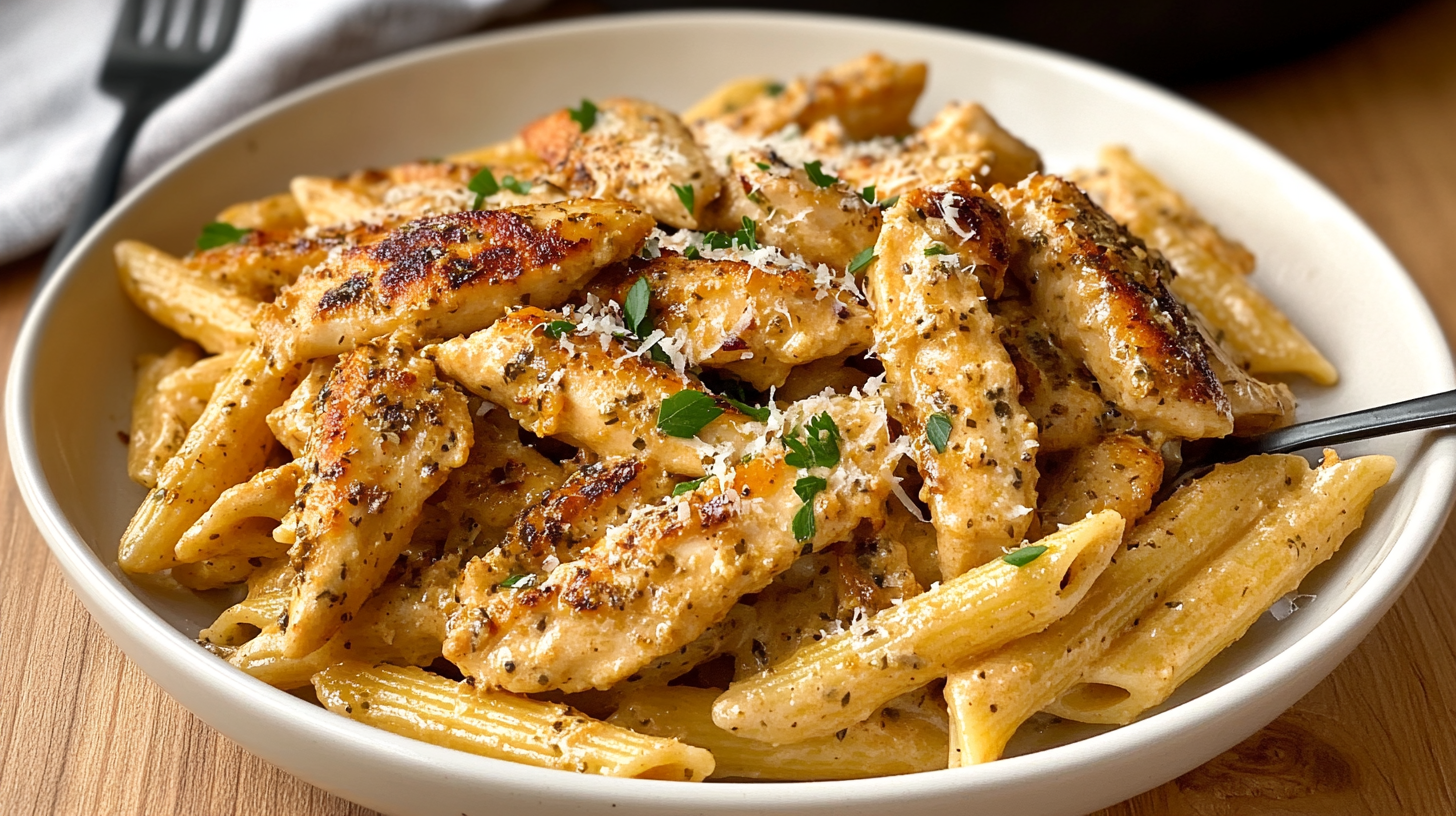Garlic parmesan chicken pasta is a dish that has become a favorite for many due to its rich flavors and comforting qualities. Combining tender chicken, creamy parmesan sauce, and perfectly cooked pasta, it is a go-to recipe for home cooks and professionals alike. The beauty of this dish lies in its versatility—whether it’s a weeknight dinner or a special occasion meal, it never fails to impress. With a balance of savory garlic, creamy parmesan, and hearty chicken, this dish embodies the essence of satisfying, flavorful cooking.
We’ll dive into the details of how to craft the perfect garlic parmesan chicken pasta. From understanding its origins to mastering the preparation process, you’ll gain everything you need to create a restaurant-quality meal at home. Let’s start by exploring where this iconic dish comes from and why it remains so beloved.
Looking for your next favorite dish? Indulge in our creamy Marry Me Chicken Pasta Recipe, or keep it light and satisfying with Grilled Chicken Wraps and Grilled Chicken Nuggets perfect for any craving!
History and Origins of Garlic Parmesan Chicken Pasta
While garlic parmesan chicken pasta may feel like a modern creation, its roots are deeply tied to Italian culinary traditions. Pasta, garlic, and parmesan have long been staples in Italian cuisine, celebrated for their simplicity and robust flavors. The addition of chicken to this classic combination likely originated as a way to create a heartier dish suitable for the American palate.
In the mid-20th century, creamy pasta sauces gained popularity in the United States, and recipes like Alfredo and carbonara set the stage for garlic parmesan chicken pasta to shine. The dish blends Italian inspiration with American ingenuity, making it both traditional and contemporary.
Over time, variations have emerged, with each cook adding their own flair. Despite the adaptations, the core ingredients—garlic, parmesan, chicken, and pasta—remain consistent. This fusion of flavors has helped solidify its status as a beloved comfort food around the world.
Table of Contents
Key Ingredients for Garlic Parmesan Chicken Pasta
To make an exceptional garlic parmesan chicken pasta, you’ll need to start with high-quality ingredients. Each component plays a vital role in achieving the dish’s signature taste and texture. Here’s what you’ll need:
- Chicken: Boneless, skinless chicken breasts or thighs work best for tender and juicy results.
- Garlic: Fresh garlic is essential for a robust and aromatic flavor. Avoid pre-minced garlic for the best results.
- Parmesan Cheese: Opt for freshly grated parmesan instead of pre-packaged varieties to ensure maximum flavor and creaminess.
- Pasta: Classic options include fettuccine, penne, or spaghetti, but any pasta shape can work.
- Cream: Heavy cream or half-and-half creates the creamy base for the sauce.
- Butter and Olive Oil: These add richness and help sauté the garlic and chicken to perfection.
- Seasonings: Salt, black pepper, and optional Italian herbs elevate the overall taste.
By using the freshest and highest-quality ingredients, you’ll ensure your garlic parmesan chicken pasta is as delicious as possible.

Choosing the Best Chicken for Your Pasta
The choice of chicken can make or break your garlic parmesan chicken pasta. While any cut of chicken can technically work, boneless, skinless options are the easiest to prepare and cook evenly.
- Chicken Breasts: These are lean and cook quickly, making them ideal for a lighter dish. However, be careful not to overcook them to avoid dryness.
- Chicken Thighs: For a richer, more flavorful option, chicken thighs are excellent. Their higher fat content ensures juicy, tender bites.
Always season the chicken generously with salt, pepper, and optional spices like paprika or Italian seasoning. Cooking techniques like pan-searing or grilling provide a golden crust that adds texture and flavor to the dish. Additionally, cutting the chicken into bite-sized pieces ensures even cooking and better distribution throughout the pasta.
Selecting the Right Pasta for the Dish
Pasta is the foundation of any garlic parmesan chicken pasta, and choosing the right type is essential for achieving the perfect bite. While personal preference plays a role, certain pasta shapes complement the dish better than others.
- Fettuccine: Its wide, flat shape holds the creamy sauce beautifully, making it a classic choice.
- Penne: The hollow tubes capture the garlic parmesan sauce, ensuring every bite is flavorful.
- Spaghetti: This long, thin pasta creates a balanced texture and pairs well with the creamy chicken mixture.
When cooking pasta, always salt the water generously to enhance its flavor. Aim for an al dente texture, as the pasta will continue to cook slightly when combined with the sauce. For added depth, reserve some pasta water to help thicken the sauce later.
How to Make the Perfect Garlic Parmesan Sauce
The creamy garlic parmesan sauce is the heart of this dish. Achieving the ideal consistency and flavor requires attention to detail and the right techniques.
- Sauté the Garlic: Start by cooking minced garlic in a combination of butter and olive oil. This step releases the garlic’s natural aroma and infuses the base with flavor.
- Add Cream: Pour in heavy cream or half-and-half, stirring constantly to avoid scalding.
- Incorporate Parmesan: Gradually whisk in freshly grated parmesan cheese, allowing it to melt and thicken the sauce.
- Season to Taste: Add salt, pepper, and optional Italian herbs like oregano or thyme for added depth.
- Adjust Consistency: If the sauce is too thick, use reserved pasta water to achieve the desired texture.
This rich and velvety sauce clings perfectly to the pasta and chicken, making every bite indulgent and satisfying.
Step-by-Step Cooking Instructions
Creating garlic parmesan chicken pasta is a straightforward process when you follow these steps:
- Cook the Pasta: Boil your preferred pasta until al dente. Reserve a cup of pasta water and drain the rest.
- Prepare the Chicken: Season the chicken and cook it in a hot skillet with butter and olive oil. Once golden and fully cooked, remove it from the pan and set it aside.
- Make the Sauce: In the same skillet, sauté minced garlic in butter until fragrant. Add cream and parmesan, stirring to combine. Adjust the thickness with pasta water if needed.
- Combine Ingredients: Return the cooked chicken to the skillet, allowing it to absorb the sauce’s flavors. Add the cooked pasta and toss everything together until well coated.
- Serve: Garnish with extra parmesan and fresh parsley for a burst of color and flavor.
By following these steps, you’ll create a perfectly balanced dish that highlights the creamy richness of garlic parmesan chicken pasta.
Tips for Enhancing the Flavor
Bringing out the best flavors in garlic parmesan chicken pasta involves a few thoughtful techniques. Start by using freshly minced garlic instead of pre-packaged options. Fresh garlic imparts a more robust and aromatic quality to the sauce. Toast the garlic lightly in butter or olive oil for added depth without bitterness.
Adding a splash of white wine or chicken broth while making the sauce can elevate the dish with a subtle tang. Another trick is to use freshly grated parmesan cheese, as it melts smoothly and contributes a sharper flavor than pre-grated varieties.
For those who enjoy a bit of heat, a pinch of red pepper flakes can add a gentle kick that balances the creamy richness of the sauce. Finally, garnish the dish with fresh herbs like parsley or basil to brighten the flavors and add a touch of freshness to every bite.
Health Benefits of Garlic Parmesan Chicken Pasta
While garlic parmesan chicken pasta is an indulgent dish, it offers surprising nutritional benefits when made thoughtfully. Garlic, a key ingredient, is packed with antioxidants and compounds that support heart health and boost immunity. Its anti-inflammatory properties add an additional layer of health benefits.
Chicken, especially when lean cuts are used, provides high-quality protein essential for muscle growth and repair. This protein-rich component makes the dish satisfying and helps with sustained energy levels.
Parmesan cheese, though rich, is a good source of calcium, supporting bone health. By incorporating whole-grain pasta and reducing the use of heavy cream, you can make the dish even healthier without compromising on flavor. When paired with a side of vegetables or a fresh salad, garlic parmesan chicken pasta becomes a well-rounded meal that nourishes the body and delights the palate.
Pairing Garlic Parmesan Chicken Pasta with Sides and Drinks
The richness of garlic parmesan chicken pasta pairs wonderfully with light, refreshing sides and complementary beverages. A crisp green salad with a tangy vinaigrette provides a vibrant contrast to the creamy pasta. Steamed or roasted vegetables like broccoli, asparagus, or zucchini are excellent options to add texture and nutrients.
For a heartier meal, serve the pasta alongside warm garlic bread or a slice of crusty baguette. The bread’s crunchy exterior and soft interior complement the creamy sauce perfectly.
When it comes to drinks, white wines like Chardonnay or Sauvignon Blanc are classic pairings, as their acidity cuts through the richness of the dish. Non-alcoholic options like sparkling water with a twist of lemon or iced tea work just as well. These pairings ensure a balanced and enjoyable dining experience.
Popular Variations of Garlic Parmesan Chicken Pasta
Garlic parmesan chicken pasta lends itself well to creative variations, allowing you to tailor the dish to your taste preferences. One popular option is to add sautéed mushrooms or spinach, which enhance the dish’s flavor profile and add a nutritional boost.
Seafood lovers often substitute chicken with shrimp or scallops for a luxurious twist. For a smoky flavor, incorporating crispy bacon or pancetta is a crowd-pleasing option. Vegetarians can replace the chicken with roasted vegetables like bell peppers, zucchini, or butternut squash, maintaining the dish’s heartiness.
For those seeking a spicy kick, try adding Cajun seasoning or crushed red pepper flakes to the sauce. Another delightful variation includes mixing pesto into the garlic parmesan sauce, creating a vibrant and herbaceous flavor. These variations keep the dish exciting and adaptable to different occasions.
Common Mistakes to Avoid When Making the Dish
Even a dish as straightforward as garlic parmesan chicken pasta can encounter pitfalls if care isn’t taken. One common mistake is overcooking the chicken, which can lead to a dry and chewy texture. Cooking the chicken just until it’s golden and tender ensures the best results.
Using pre-grated parmesan cheese is another misstep, as it often contains anti-caking agents that can prevent smooth melting. Opt for freshly grated parmesan to achieve a silky sauce. Similarly, neglecting to reserve pasta water can leave you with a sauce that’s either too thick or too dry.
Avoid adding cream to the pan before sautéing the garlic; doing so can dull the garlic’s aroma and flavor. Lastly, don’t skip seasoning each component of the dish. Properly seasoned chicken, pasta water, and sauce result in a well-balanced and flavorful dish.
Serving and Presentation Tips
Presentation plays a key role in elevating the experience of enjoying garlic parmesan chicken pasta. Serve the pasta on a flat, wide plate to showcase its creamy texture and vibrant garnishes. Twirl the pasta neatly using tongs or a fork for a visually appealing presentation.
Top the dish with a sprinkle of freshly grated parmesan cheese and finely chopped parsley for a burst of color. For an extra touch, add thin slices of garlic that have been fried until golden, creating a decorative and flavorful garnish.
Serving the pasta with freshly baked garlic bread or a side salad enhances the overall aesthetic. To ensure the dish remains warm when served, preheat the plates in an oven or microwave. These small details make the meal feel special and restaurant-quality.
Storing and Reheating Garlic Parmesan Chicken Pasta
Garlic parmesan chicken pasta can be stored and reheated successfully with a few simple techniques. Store leftovers in an airtight container in the refrigerator, where they’ll stay fresh for up to three days.
When reheating, avoid using a microwave directly, as it can dry out the sauce and make the pasta gummy. Instead, transfer the pasta to a skillet and reheat it over low heat. Add a splash of milk, cream, or reserved pasta water to restore the sauce’s creamy consistency.
For longer storage, freeze the dish in a freezer-safe container for up to two months. When ready to serve, thaw it overnight in the refrigerator before reheating. Following these steps ensures your garlic parmesan chicken pasta remains as delicious as the day it was made.
FAQs
Can I put Parmesan in my spaghetti sauce?
Yes, you can absolutely put Parmesan in your spaghetti sauce! Parmesan cheese adds a rich, nutty flavor and enhances the overall taste of the sauce. It works especially well in creamy or tomato-based sauces. When adding Parmesan, it’s best to use freshly grated cheese for optimal texture and flavor. You can stir it directly into the sauce to thicken and enrich it or sprinkle it on top of the finished dish for added depth.
What is Parmesan garlic sauce made of?
Parmesan garlic sauce is typically made from a combination of butter, garlic, cream, and freshly grated Parmesan cheese. The garlic is usually sautéed in butter to release its flavor, then mixed with cream to create a rich base. Parmesan is whisked in gradually, melting into the mixture to form a smooth and creamy sauce. Some variations also include olive oil, chicken broth, or herbs like parsley or oregano for added flavor. This sauce is versatile and pairs beautifully with pasta, chicken, or vegetables.
Do Italians put Parmesan in tomato sauce?
While Parmesan cheese is often associated with Italian cuisine, Italians don’t traditionally add Parmesan directly to tomato sauce while cooking. Instead, they prefer to use Parmesan as a garnish, sprinkling it over the pasta after the sauce has been added. This allows the cheese to enhance the flavor without overpowering the sauce. However, grated Parmesan may occasionally be used in recipes for specific regional dishes or to thicken sauces like ragù.
What is the oldest pasta in the world?
The oldest known pasta in the world was discovered in China, dating back over 4,000 years. Archaeologists found remnants of noodles made from millet at the Lajia archaeological site along the Yellow River. This discovery suggests that pasta, or noodle-like dishes, originated much earlier than previously thought. While Italy is famous for its pasta, ancient civilizations across Asia and the Middle East also developed early forms of pasta independently, showcasing the universal appeal of this versatile food.
Conclusion and Final Thoughts
Garlic parmesan chicken pasta is a dish that combines simplicity with indulgence, making it a favorite for countless households. With its creamy garlic sauce, tender chicken, and perfectly cooked pasta, it delivers a meal that satisfies every time.
By selecting high-quality ingredients, paying attention to techniques, and exploring creative variations, you can craft a version of this dish that suits your preferences. Pair it with the right sides and beverages, and it becomes the centerpiece of a memorable dining experience.
Whether you’re cooking for a casual dinner or a special occasion, garlic parmesan chicken pasta never disappoints. With the tips and insights shared in this guide, you’re now equipped to create a masterpiece in your own kitchen. Happy cooking!


